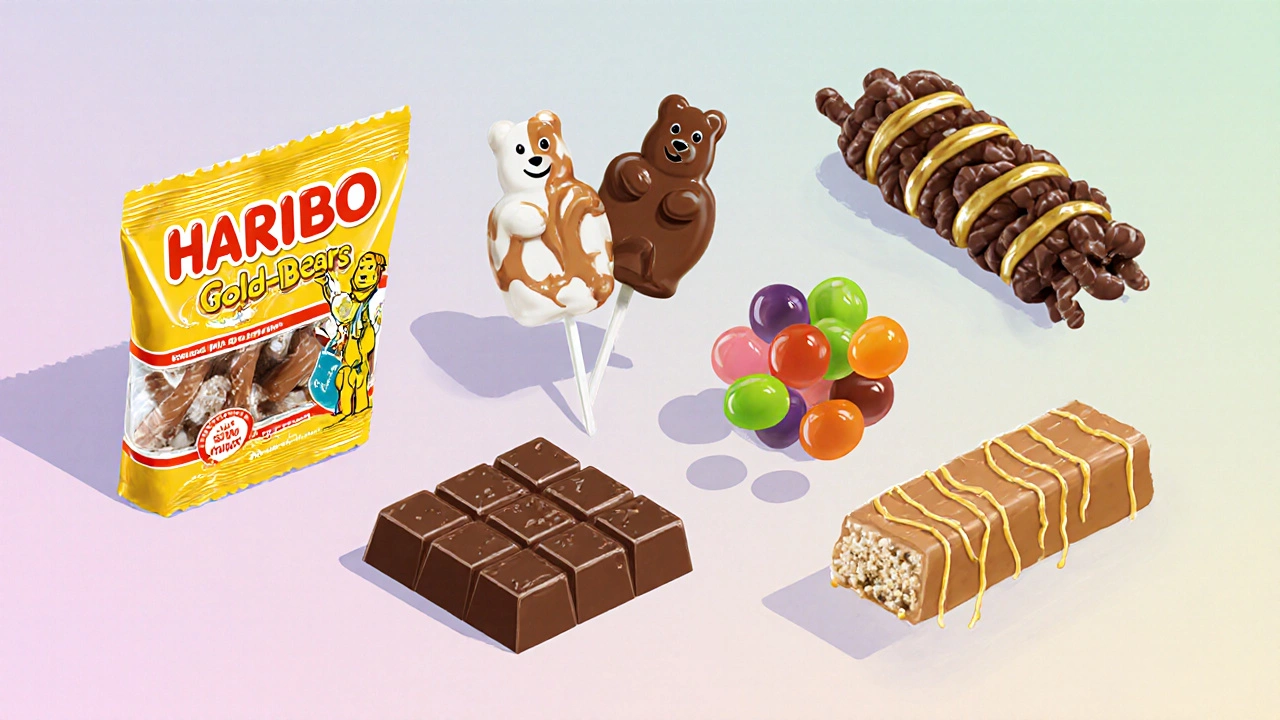When you reach for a handful of sweets, you probably aren’t thinking about animal products at all. Yet many popular candies hide ingredients that make them off‑limits for vegans. This guide spells out exactly which candies cross the line, why they’re not vegan, and how to spot the hidden animal‑derived culprits on the package.
Key Takeaways
- Gelatin, pork‑derived fats, milk‑based chocolates, honey, and certain glazing agents are the most common non‑vegan ingredients.
- Brands that use gummy textures, marshmallows, or caramel centers are often loaded with animal products.
- Reading the ingredient list (look for terms like "gelatin", "l‑cysteine", "confectioner's glaze", "beeswax") is the safest way to stay vegan.
- There are plenty of vegan alternatives; many manufacturers now label their products as "vegan" or use plant‑based gelling agents such as pectin or agar‑agar.
- Keep a quick cheat‑sheet of the most notorious non‑vegan candies for easy reference while shopping.
Why candy can be non‑vegan
Most people assume candy is just sugar, flavor, and colour. In reality, texture and shelf‑life often rely on animal‑derived substances. The food industry uses these ingredients because they provide chewiness, shine, and stability that plant‑based alternatives struggled to match - until recent advances in food tech.
Common animal‑derived ingredients
Below are the ingredients you’ll encounter most often, each with a short description of what it does in candy.
- Gelatin is a protein extracted from animal collagen, usually pork or beef, that gives gummy candies their firm, bouncy texture.
- Pork fat is rendered fat used in some chocolate coatings and nougat to add richness and a glossy finish.
- Milk chocolate is chocolate that contains milk powder or condensed milk, making it unsuitable for vegans.
- Honey is a natural sweetener produced by bees, often used in place of corn syrup for its flavour profile.
- Confectioner's glaze is a glossy coating made from shellac, a resin secreted by the lac insect, which adds shine to sweets like jelly beans.
- L‑cysteine is an amino‑acid derived from feathers or hair, used to improve texture in licorice and some chewy candies.
- Beeswax is a wax from honey‑comb that creates a protective coating on certain hard candies.

Popular non‑vegan candies (and the animal ingredient they contain)
The following list covers many mainstream brands you’ll see in Australian supermarkets and convenience stores.
- Gummy bears - typically contain gelatin for that characteristic chew.
- Haribo Gold‑Bears - use pork‑derived gelatin; the packaging often lists "gelatin (pork)".
- Chocolate‑covered marshmallows (e.g., Dove Marshmallow Pops) - marshmallows are made with gelatin and sometimes milk powder in the coating.
- Caramel candies (e.g., Werther’s Original) - contain milk and butter for a creamy texture.
- Licorice twists - many commercial versions use l‑cysteine and sometimes gelatin to achieve a soft bite.
- Jelly beans (certain flavors) - the shiny finish often comes from confectioner's glaze, which is non‑vegan.
- Honey‑sweetened chocolate bars (e.g., Cadbury Dairy Milk with Honey) - obvious due to the honey ingredient.
- Nougat‑filled candy bars (e.g., Snickers, Mars) - nougat contains egg whites and milk for its light, airy structure.
- Caramel popcorn (e.g., CrackerJack) - caramel glaze often includes butter and milk solids.
How to spot non‑vegan candies on the label
Even if you’re familiar with the ingredient names above, manufacturers don’t always list them clearly. Use these tricks while shopping:
- Check the “Allergy Information” box - gelatin, milk, egg, and honey are usually flagged for those with allergies.
- Look for vegan certification logos (e.g., Vegan Society, Plant‑Based). Lack of a logo doesn’t guarantee non‑vegan, but it’s a quick flag.
- Beware of vague terms like "natural flavour" or "fruit concentrate" - they can hide animal‑derived components.
- Search for "shellac", "confectioner's glaze", "beeswax", "l‑cysteine", or "pork" in the ingredient list.
- If the label mentions "contains dairy" or "contains egg", the candy is definitely not vegan.
Vegan candy alternatives
Good news: the market for plant‑based sweets is exploding. Here are some reliable vegan-friendly options you can find in Melbourne and online.
- Fruit‑based gummies - use pectin or agar‑agar instead of gelatin. Brands like Fruit Tart and Glee Gum are popular.
- Vegan chocolates - made with cocoa butter and soy or oat milk. Look for Thrive Dark or Noblesse lines.
- Vegan marshmallows - crafted from aquafaba (chickpea water) for fluffiness. Better Than Boo offers a range of flavours.
- Honey‑free caramels - use coconut sugar or maple syrup. Vow Sweetness sells a buttery‑soft caramel.
- Glaze‑free jelly beans - the “Rainbow Bean” line from Jelly Belly now ships a vegan version without shellac.

Quick checklist for vegan candy shopping
- Does the label list gelatin, pork fat, milk, egg, honey, or beeswax? - NO if you want vegan.
- Is there a vegan certification symbol? - Helps, but still read the full list.
- Is the texture gummy, chewy, or marshmallow‑like? - Verify the gelling agent (pectin/agar vs gelatin).
- Are you buying from a trusted vegan‑friendly brand? - Stick to brands that publish ingredient sourcing.
Comparison table: Non‑vegan vs Vegan candy attributes
| Attribute | Non‑vegan candy | Vegan candy |
|---|---|---|
| Primary gelling agent | Gelatin (pork or beef) | Pectin or agar‑agar (plant‑based) |
| Common animal-derived additives | Milk powder, egg whites, honey, l‑cysteine, beeswax | None (uses soy lecithin, coconut oil) |
| Typical flavour profile | Rich, buttery, creamy | Bright, fruit‑forward, less creamy |
| Label clues | "Contains milk", "gelatin", "egg" | "Vegan", "plant‑based", "no gelatin" |
| Allergen concerns | Milk, egg, soy (if added) | Usually soy‑free, may contain nuts |
Frequently Asked Questions
Is gelatin always made from pork?
No. Gelatin can come from pork, beef, or even fish. In most Western candy, pork gelatin is the default because it’s cheap and widely available.
Can I rely on the term "natural flavour" to mean vegan?
Not safely. "Natural flavour" can be derived from animal sources such as dairy or meat extracts. Always check the full ingredient list or contact the manufacturer.
Are gummy vitamins vegan?
Only if they’re specifically labelled vegan. Many gummy supplements still use gelatin, so verify the packaging.
What’s the difference between "vegan" and "vegetarian" on candy labels?
Vegetarian means no meat, but dairy, eggs, and honey are allowed. Vegan excludes all animal‑derived ingredients, including dairy, eggs, honey, and any processing aids from animals.
How can I find vegan candy online in Australia?
Websites like Vegan Treats Australia, Greenlife Foods, and larger retailers such as Woolworths and Coles now have dedicated vegan candy sections. Look for the vegan badge or filter by "plant‑based".